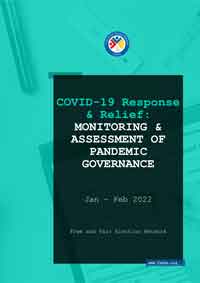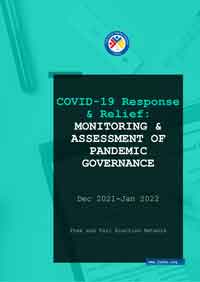- Health sector, policy reforms necessary under Pakistan’s Covid-19 response
- Enforcement of robust evaluation of price regulatory regime need of the hour
- Pakistan lags behind neighboring countries in conducting COVID-19 tests
- 100 million people fully vaccinated
ISLAMABAD, March 20, 2022: Free and Fair Election Network (FAFEN) has observed varying healthcare capacities across regions and districts during the fifth wave of COVID-19 pandemic that remained a major challenge and a key concern. With the onset of the spread of the Omicron variant starting in December last year, confirmed cases jumped to 133,839 in January – the highest since the start of the pandemic – while the number of recoveries was reported at 38,366. Compared to January, the cases started declining in February, with 79,855 confirmed cases and 147,548 recoveries reported in the same month.
FAFEN’s findings of the third pandemic governance monitoring report, released on Sunday, reinforce the need for consistent and continued vigilance and the necessity of both medium and long-term structural and policy changes built on the lessons learnt. The report covers Pakistan’s COVID-19 response during January-February 2022.
Compared to the earlier waves, the report highlights a broad two-pronged pandemic response to the fifth surge of COVID-19 that helped Pakistan withstand and manage the challenges relatively well. The first aspect of the response comprised varying levels of restrictions and targeted measures in areas with high positivity rates. The second wave comprised a parallel push for increased vaccination and broadening the eligible population section to include the 12-16 age group. A remarkable increase of 30 million to the fully vaccinated column during the first two months of the ongoing year is a testament to the seriousness accorded to the effort.
Despite a slow start, Pakistan’s vaccination drive gained significant momentum, reaching an average of one million doses per day by the end of last year. Pakistan had administered 216.9 million doses of the COVID-19 vaccine by the first week of March 2022. Approximately 100 million people were fully vaccinated (65 percent of the vaccine eligible population and 44 percent of the total estimated population), whereas around 127.5 million are ‘partially vaccinated’ as per the information provided by the NCOC website and their official Twitter account. The numbers reflect a major and significant achievement in the fight against the COVID-19 pandemic. The report, however, cites several areas that require attention.
Clarity and public release of detailed data will help all key stakeholders better assess and oversee the government’s pandemic response whilst simultaneously allowing civil society and aid organizations to sharpen their focus on areas and segments of the population that are lagging or marginalized. For instance, the official data as provided for the fully and partially vaccinated population warrants an elaboration to avoid misinterpretation of the data.
Similarly, the need for the public release of vaccination data at the regional and district levels, disaggregated by gender, age-group, and demographic divide will go a long way in informing all key stakeholders to fine-tune their efforts and engagements. At the moment, such data is not publicly available.
As assessed in the report, had the Omicron variant been as severe as the earlier variants, it would have seriously tested the health care system—a factor that shall not be lost on policymakers responsible for responding to any new variant of COVID-19 or a completely new pandemic. For instance, the availability of beds, ventilators, and doctors within the observed districts shows that the healthcare system in Pakistan is still underequipped—more so in some areas than others.
If the situation had necessitated the hospitalization of those infected, the number of patients per ventilator and patients per bed would have resulted in severe consequences for some of the districts. For instance, Karak district of Khyber Pakhtunkhwa would have 21,132 and 1,023 patients per ventilator and bed respectively, followed by Mardan with 669 patients per ventilator and 324 patients per bed, and Rawalpindi with 204 patients per ventilator and four patients per bed.
The variance in testing numbers across regions and districts is yet another concern – a result reflecting a host of issues ranging from logistic to economic and social. The total number of public and private testing facilities within the 59 districts observed in this cycle were 91 and seven, respectively. It is pertinent to note that barring select districts, the testing numbers for most of the districts are not publically available. Testing numbers and ratios are significantly varying for the districts whose data is available. Although Pakistan has improved in terms of expansion of COVID-19 tests, it still lags behind the neighboring countries. Overall, Pakistan continues to rank at 164 with 115,908 tests per one million population, while Iran and India rank at 116 and 118 (with 550,887 and 547,226 tests) globally.
The private sector has played a significant role in providing services and facilities that have contributed to the overall pandemic governance and response. However, there remains the need for more effective regulation, especially regarding the pricing of critical services. The five EDOs who were interviewed reported 85 private facilities and 37 facilities established by the welfare organizations that provided COVID-19 related treatment. Augmenting the 289 ventilators in the public sector facilities, the private sector health facilities were a significant 152 ventilators as reported by the EDOs of the five districts.
However, what remains a key concern for the government is the issue of price regulation. Attendants of patients interviewed at various health facilities highlighted the significant variance in test pricing. The respondents claimed to have paid prices ranging between PKR 1,000 and PKR 15,000 or more. Coupled with reported shortages of some medicines during the same period, the situation demands a robust evaluation of the price regulatory regime and the equally significant enforcement mechanism that whilst building on the benefits of the private sector’s investments also safeguards the interests of the citizens.
To download the complete report, click here | To download Urdu Press Release, click here




